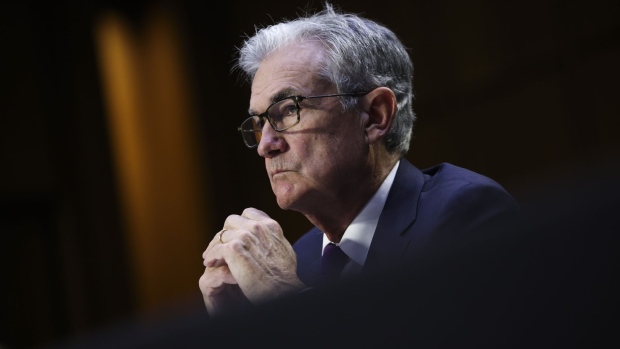Oct 22, 2021
Fed on Track to Taper, Inflation Will Come Down, Powell Says
, Bloomberg News

(Bloomberg) -- The Federal Reserve is on track to begin tapering its bond-buying program and inflation should come down once supply-chain constraints pushing up prices ease, Fed Chair Jerome Powell said.
“We are on track to begin a taper of our asset purchases that, if the economy evolves broadly as expected, will be completed by the middle of next year,” Powell said Friday during a panel discussion at a virtual event hosted by the South African Reserve Bank. “I do think it is time to taper and I don’t think it is time to raise rates.”
Global supply-chain constraints and shortages that have led to elevated inflation “are likely to last longer than previously expected, likely well into next year,” Powell said, while adding that “it is still the most likely case” that as those constraints ease, “as they eventually will -- and as job gains move up -- inflation will move back down closer to our 2% goal.”
Powell and his colleagues on the U.S. central bank’s policy-setting Federal Open Market Committee are expected to announce at the conclusion of their upcoming Nov. 2-3 policy meeting that they will begin winding down the bond-buying program put in place last year in the early days of the pandemic.
Currently, the Fed is acquiring $120 billion of Treasuries and mortgage-backed securities each month, and the coming reduction in the pace of purchases will mark the central bank’s first step toward the exit from the monetary support measures rolled out in 2020 to shield the economy from the effects of the coronavirus.
Investors also increasingly expect Fed officials to begin raising their benchmark interest rate, which is currently just above zero, as soon as the middle of next year. The timeline for expected rate increases has been pulled forward in money markets in recent weeks amid unfavorable news about inflation, which is running well above the central bank’s 2% target amid global supply-chain disruptions that are boosting prices for a wide range of goods and services.
Powell said the risk is that the current elevated rates of inflation “will begin to lead price- and wage-setters to expect unduly high rates of inflation in the future.”
“If we were to see a serious risk of inflation moving persistently to higher levels, we would certainly use our tools to preserve price stability while also taking into account the implications for our maximum employment goal,” he said.
The number of Americans currently employed is still millions below where it was just prior to the pandemic, and the pace of rehiring slowed in August and September as the delta variant swept across the country. Fed officials see the level of job gains accelerating in the coming months as the latest wave of cases subsides.
©2021 Bloomberg L.P.